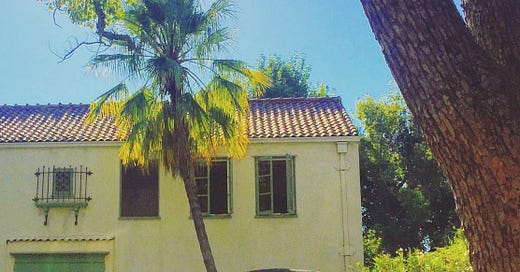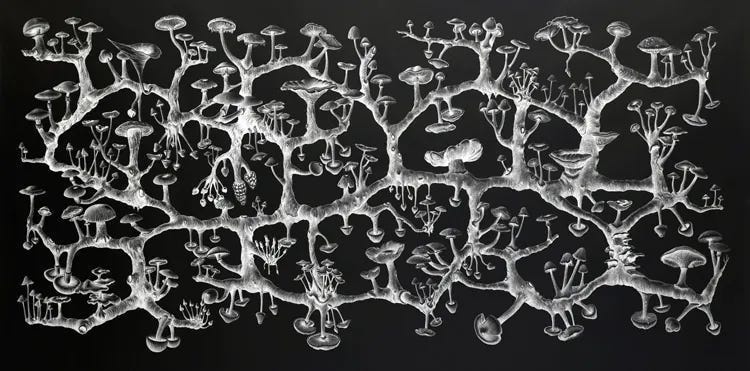The Anatomy of Formlessness
Some things don’t need to be straightened out. Pasadena, California.
Tldr: Think of being formless as an experiment. There are 4 rules:*
- You are not any one thing
- Contradictions are permissible and even encouraged*
- You are fluid
- You have (the illusion of?) agency
In this (post-?) postmodern world, the expectation recedes that our identities are crystalline. If you identify as a postmodernist, you might also identify as a cat. You might’ve already had nine lives, or perhaps you’re in the middle of your third, depending on how you distinguish each cat life.
There are countless ways one might define various chapters of their lives.
Let’s explore a few.
Location
This is quite self-explanatory. Your entire environment changes.
Profession
Occasionally, you’ll hear that someone reinvented themself at 40, but what they’re really alluding to is a career change. Brad Pitt used to drive limos for strippers before he was an actor, Stephen King was a janitor before he became a prolific novelist, and Steve Jobs was an acidhead before he was the Steve Jobs.
Relationships
Chapter defining relationships could be anything from familial ties, to friendships, to romantic relationships. Think about Tom in the aptly named 500 Days of Summer, whose life was predicated on his romance with Summer for 500 days, until he met Autumn. This framework, though, could even extend to periods of communal belonging - like joining an ashram!
Pre- and post- formative trauma, grief, or self-revelation.
Certain moments in our lives become discontinuities. It can feel like our identities have distinct ‘befores’ and ‘afters’ as a product of a particular event. From a death to a sexual assault, or even finally embracing an aspect of one’s identity that was once concealed (I’m thinking of ‘coming out’) — these moments not only reshape us, but revise our understanding of the world.
An instrumental song by Ariel Pink called “Non Sequitor Segueways,” both in name and in substance, alludes to something notable about these moments — that they are both a period and a conjunction.
This last point elicits notice. One thing can be many things.
An idiom: we are multidimensional beings.
Each item on this list creates a sort of external framework that we respond to internally, shaping us. But, writing our biographies in this way is limiting. These notions of self concept are collecting dust. We end up sectioning off separate story lines without acknowledging the extent to which they blend.
Our lives are dynamic impressionist paintings of innumerable variables bleeding into each other. Brush strokes and colors from different themes might become more striking or soft as we move through time.
Who we are in each breath is a still life of that ephemeral blend of external influences and internal architecture. But, both the internal and external change with each passing moment.
It’s a dynamic feedback loop.
Maybe your heart is reeling from a break up, but for a fleeting twenty minutes the sky is set ablaze during sunset. You may not initially notice the sky because you’re consumed by heartache, but gradually, the sky may briefly alleviate that gnawing sense of turmoil.
If we acknowledge that we are all shapeshifters, it allows us to circumvent our tendency to lean towards a central narrative. A shapeshifter’s identity is by definition fluid. For these mythical creatures, ongoing metamorphosis is the connective tissue — the underlying characteristic. They inhabit the liminal. It’s worth embracing because it unlocks previously imperceivable possibilities.
Suddenly, there’s no need to segregate between subjects. Science and spirituality - let’s go there. I don’t care if they mix like water and oil. A confluence of the left and right brains.
Even this title, “anatomy of formlessness,” is paradoxical, but that’s the point. It’s the liminal space between that matters and ultimately where our existence plays out.
“Our western mind,” said Carl Jung (you could say I’m a fan girl), “lacking all culture in this respect, has never yet devised a concept, not even a name for the union of opposites through the middle path, that most fundamental item of inward experience which could respectably be set against the Chinese concept of Tao.”
While relatively nameless, a middle path is not exclusive to the Tao. It’s embedded in the world around us. Even in botany. As an alternative to an arboreal type of plant that grows from a central stem or trunk, a rhizome disobeys these rules. It is a subterranean plant stem that has roots, which grow horizontally, and shoots that can grow vertically (sometimes emerging from the ground), and they all connect through nodes. It is a nonlinear network.
Ginger, turmeric, and banana are all rhizomes.
Mycelium Rhizome. Richard Giblett. 2008. (Graphite on paper, 120 x 240 cm. Inverted).
The term rhizome became en vogue in the 1960s when French post-structuralist ideologues wanted to transcend ‘the box.’ They bucked trends of duality and hierarchy in favor of recontextualizing concepts outside of pre-formulated structures, emphasizing dynamism and interconnectedness.
They believed that structures were heavily influenced by language. Unironically, many of these philosophers refused to be categorized as post-structuralists given the very nature of succumbing to any title.
Like most things, words have their perks and their drawbacks. On one hand, they give us means to communicate. On the other hand, they narrow the breadth of an original concept, idea, or experience, whittling them down to the eye of the spectator.
Admittedly, I’m doing that now as I write – and you are as you read. But, my alternative is to shut up and my soul won’t let me quit.
Gilles Deleuze and Félix Guattari were two of these Frenchies who wrote a book, A Thousand Plateaus, which proposed that information and knowledge were not organized like a tree where information sprouts from a central trunk, but rather like a rhizome.
They also proposed a rhizomatous model of identity. In this model, there is no discrete beginning or ending; no particular dimensions; a completely open and unbound system; both the shape and the substance within it are transient.
Think about it. When did your identity actually begin?
Bruce Lee, the martial artist, got it, “Empty your mind, be formless. Shapeless, like water. If you put water into a cup, it becomes the cup. You put water into a bottle and it becomes the bottle. You put it in a teapot, it becomes the teapot. Now, water can flow or it can crash. Be water, my friend.”
Except, I’d add - even the water doesn’t have to be water – it can be anything. In reality – everything flows. Glass melts over time, mountains morph, and slabs of Earth subduct. Planets are destroyed, stars explode. EVERYTHING is moving all the time.
Here are rules of formlessness. I know, it’s paradoxical (see #2).
You are not any one thing
You are many. You are infinite.
(I suppose you are both one thing and infinite, but that is another rabbit hole for another day).
Contradictions are permissible and even encouraged
You can be sweet and a psycho. You can be an intellectual who likes to watch Love is Blind. You can be a scientist who is obsessed with astrology. Be a hunter and a vegetarian. You can identify with post-structuralist theory and embrace the power of words to communicate those ideas.
Some of the most interesting edges of our experience can emerge from contradictions.
You are fluid
It’s okay to not have a forged sense of self. Meander. Your identity is an amorphous, shapeshifting receptacle that allows experiences to pass through it. Some days you are sharp and other days you’re flat; some days you’re fast, others you’re slow.
You have agency
You are malleable, but not a victim of circumstance. Being constantly under construction, always in motion, is an intentional endeavour. You can choose how to emerge from each interaction; you choose what to keep and leave behind in each moment. (Whether this choice is an illusion or not is a subject for later).
If you feel stuck, do something about it. Each new piece of knowledge, each breath, each sight, each interaction with the world outside of you has the capacity to change you and vice versa. Be open to it.
Embrace formlessness like an experiment in awareness. Observe what happens.
Like identity, this whatever-it-is-I’m-doing-here isn’t to be nailed down. That’s sort of the point. It’s an emerging output of moving through the liminal, through whatever medium happens to be the most appropriate at the time.
On brand with multiplicity: this project is also a multi-directional channel. I hope that you’ll consume it, reflect on it, and discuss your own thoughts and ideas about it – with me or literally anyone! It's an invitation to go trekking or on safari, to learn, to co-create something and watch what happens – without a particular destination in mind.





I think I’ve always thought of myself as a mix of contradictions and many things. So yes, I’m fluid, I couldn’t agree more. But it takes time and a hard work on your mind setting to get to that point ( I know my journey is really really long). Thanks for sharing this brilliant post with us ( I really needed to take a bit of time with myself)
This is so eloquent and thought provoking! The idea of fluidity has been on my mind so this has accompanied those thoughts well.